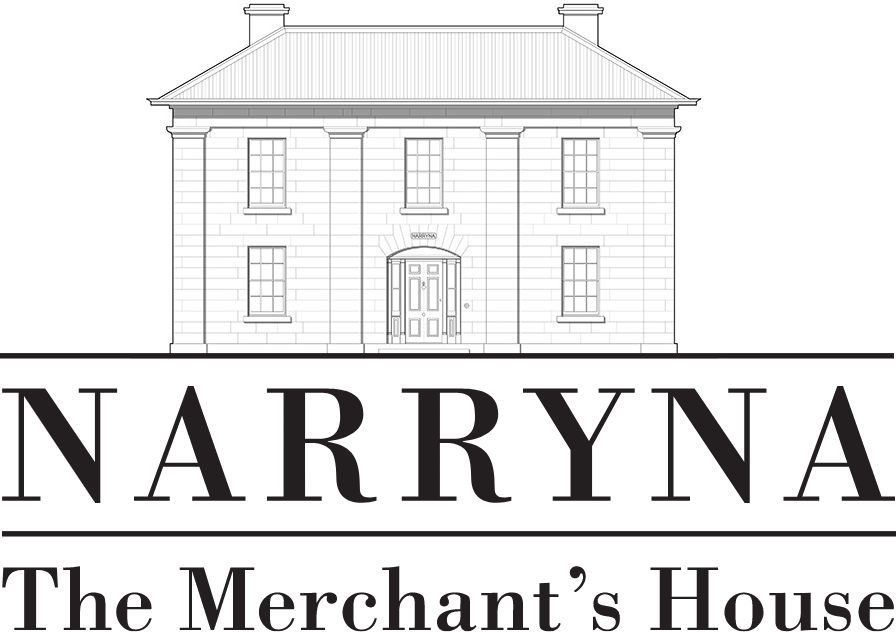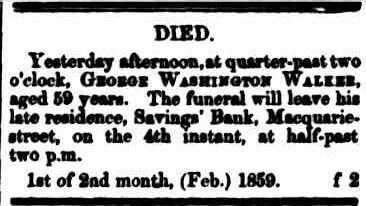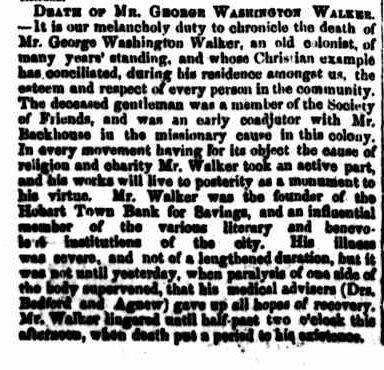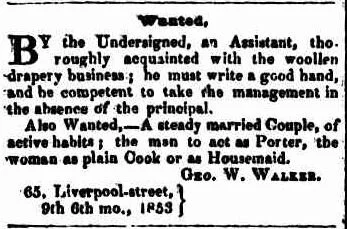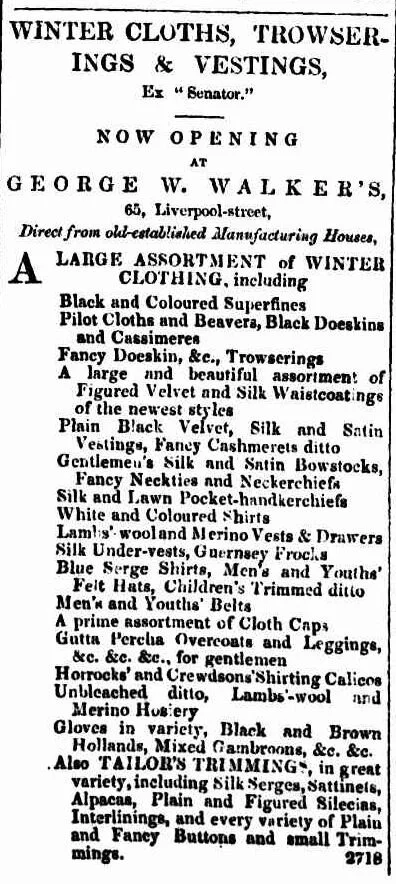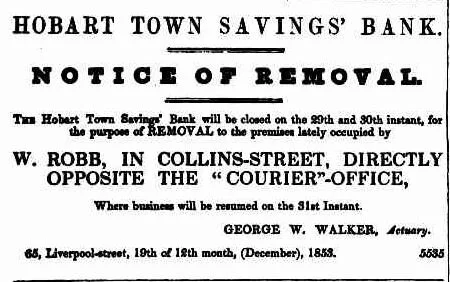George Washington Walker
Between 1852-1854 Narryna was home to George Washington Walker, his wife Sarah Benson Walker (née Mather) and their children. They belonged to the Society of Friends (Quakers) and George, a linen draper, banker and humanitarian has left a significant legacy to the life of Hobart Town.
George Washington Walker was born on the 19th March 1800 in London, the 21st child of John Walker by his second wife Elizabeth (née Ridley). His mother died when he was young and, as his father was involved in the saddle trade in Paris, he was raised by his grandmother near Newcastle. He was educated till he was 14 by a Wesleyan school master and then apprenticed to a Quaker linen draper for whom he had such great admiration that he changed from the Unitarian church of his family and became a member of the Society of Friends in 1827. He was also influenced in this decision by James Backhouse a leading Quaker minister. In 1828 he established the first Temperance Society in Newcastle.
In 1831 George Washington Walker accompanied James Backhouse as they travelled on a nine year mission ‘under concern’ to the colonies of Australia and South Africa, looking into the conditions of convicts and Aboriginal people aiming to ‘discharge a duty of Christian love’. They were supported by the Quakers in England and returned to them, information about convict and aboriginal welfare and opportunities for emigrants. Backhouse demonstrated initiative and was adventurous; Walker was methodical with secretarial skills. The entry in The Australian Dictionary of Biography for Walker describes their caring journey:
As they visited from house to house or presented to large gatherings their version of a simple practical Christianity, they encouraged schools for the poor, temperance, cleanliness and care in hospitals, humane treatment of the insane, and generally tried to arouse a social conscience among the inhabitants of every colony
In 1840 Walker returned from South Africa to Hobart Town to marry Sarah Benson Mather, daughter of Robert and Ann (née Benson) Mather, whose Methodist family had turned Quaker.
With the help of English Friends he set up a linen drapery business in Liverpool Street with a section for the distribution of bibles, temperance pamphlets and religious tracts. ‘The Pledge’ promising temperance was available to sign.
In 1845 he opened the Hobart Savings Bank beside his business to encourage saving by poorer people. It is for this that he is best remembered.
The function of the bank in the words of the Quaker draper, Walker, was as follows :
The encouragement of frugality, prudence, and industry in the community, and more particularly to enable working classes to improve their circumstances, by means easily within their reach. It offers to all who choose to avail themselves of its advantages a safe mode of investing their savings, affording them not only security but interest for their money, and the liberty of withdrawing either the whole or any part whenever needed.
By the end of the first year of trading 601 accounts were in operation (The Courier, February 20, 1845, p. 3).
He sold his linen drapery stock at the end of 1853 and restricted his trade to plain woollen goods. He was concerned by vanity and did not want to contribute to gaiety of dress. In 1847 he was publicly thanked by a group of shop assistants for inducing other shopkeepers to adopt 7 o'clock closing, but in 1855 he was publicly threatened with tar and feathering for organising his Temperance Committee into vigilante bands to enforce the law of Sunday closing of public houses.
At the end of January 1854 Walker moved his business and also the bank from Liverpool Street to a premises in Collins Street opposite the Hobart Town Courier (the location of The Imperial building today.) Towards the end of October that same year, Walker was advertising that the bank would be moving into the Stone Buildings at the corner of Macquarie and Murray streets and directly opposite St David’s Church. (His advertisement does not mention that at that stage it was also opposite the Hobart Gaol in Macquarie Street!)
The family resides at Narryna
Towards the end of 1852 and certainly by February 1853 (according to records of convicts contracted to them) the Walker family moved out of the premises above the shop in Liverpool Street and became tenants in the much more spacious Narryna in Hampden Road. The house was owned by Maria Lempriere at this time. Hampden Road was the main road into Battery Point and the houses there and the Salamanca warehouses had received an unpolluted piped water supply since 1835. It was a healthier situation for the children with its garden, elevated location, fresh air and view of the harbour.
On 13 August 1853 Walker wrote to his friend Josiah Forster:
We have great reason to mark the goodness and tender dealing of our heavenly father with us. The children, now seven in number, are all healthy as relates to body and mind, whilst around us, on every hand, sickness and mortality have been making fearful ravages. At no period in the history of the Colony has the mortality among children been so high … all probably traceable in some measure to atmospheric influences; such at least is the opinion of some of our medical men.
(James Backhouse and Charles Tylor, The Life and Labours of George Washington Walker of Hobart Town, Tasmania, London, 1862, page 534).
Although the family was living at Narryna, Walker’s business premises were still at 65 Liverpool Street till the end of 1853 and he continued to use the latter address. There are records of the convict women being allocated to him at Hampden Road in February 1853 and Sarah, his wife, in her reminiscences, My Memories of Life in Hobart Town, written in 1884, writes: ‘About the end of 1852, my husband leased the house ‘Narryna’, at Hampden Road…”’ Walker advertised in the Colonial Times in 1853 for free servants to employ:
Wanted, BY the Undersigned, an Assistant, thoroughly acquainted with the woollen drapery business; he must write a good hand, and be competent to take the management in the absence of the principal. Also Wanted, - A steady married Couple, of active habits; the man to act as Porter, the woman as plain Cook or as Housemaid. GEO. W. WALKER 65, Liverpool-street
(Colonial Times, Tuesday 14 June 1853, p. 3).
Note that Walker gives his address as 65 Liverpool Street, his business premises, rather than, it would seem, his home address.
Life was not easy for the Walkers and their growing family at Narryna, especially for Sarah who had her 8th child, Margaret Bragg Walker in 1853. The Walker’s eventually had ten children. No wonder they needed servants!
As reported in a letter written by Walker on 24 October 1853 to their eldest son, James Backhouse Walker, who at the time was studying in England.
Thy dear mother gave birth to a little girl on the 15 of last month … I had hoped thy dear mother would have written to thee, but thou has no idea of the difficulties she has to encounter with regard to servants. For months we have been without a kitchen maid, and for some time we were also without a housemaid, and could only now and then procure a charwoman as a favour at four shillings a day! This state of things renders thy poor mother a perfect slave.
Two convict servants who were contracted to the Walkers during 1853, Elizabeth White and Margaret Gray, both married at St George’s Church during the year, (one in April and one in July) and left Narryna, contributing to this predicament. Elizabeth White, a spinster, aged 25, married a convict William Evans, a clerk, on 25 April 1853. Margaret Gray, a widow, aged 37 married William Pearce, aged 41, a coachman on 25 July 1853. There were many more males than females in the colony so women were in strong demand as wives. It was usual for a woman to be assigned to her husband (rather than an employer) after their marriage.
Image 3: Margaret Bragg Walker, aged 16, 1869. Photograph taken by Charles A. Woolley who had a studio in Macquarie Street.
Sadly, Margaret only lived to the age of 17, dying at the Savings Bank Hobart Town in 1870 of Scrofula (a disease with glandular swellings, probably a form of tuberculosis). Mesenteric Disease is the term in brackets.
Towards the end of October 1854 Walker was advertising that his bank in Collins Street would be moving to the Stone Buildings on the corner of Macquarie and Murray Streets. The Walker family moved at about this time into premises above this bank. This would have been much more central and maybe more easily managed than a large house, as well as probably being more economical. By now the Walkers had a family of ten children. The family lived here from 1855-1859.
George Walker died of paralysis (probably a stroke) on 1 February 1859 at the age of 59. His funeral left from the Savings Bank at the Stone Buildings.
Image 5: Death Registry entry for George Washington Walker 1 February 1859.
Death & Funeral notices for George Washington Walker
Family Notices (1859, February 2). The Hobart Town Daily Mercury (Tas. : 1858 - 1860), p. 2. Retrieved March 18, 2021, from http://nla.gov.au/nla.news-article3252909
GENERAL INTELLIGENCE. (1859, February 1). The Courier (Hobart, Tas. : 1840 - 1859), p. 3. Retrieved March 18, 2021, from http://nla.gov.au/nla.news-article2466578
GEORGE WASHINGTON WALKER, ESQ. (1859, February 2). The Hobart Town Daily Mercury (Tas. : 1858 - 1860), p. 2. Retrieved March 18, 2021, from http://nla.gov.au/nla.news-article3252923
George W. Walker was buried in the Friends burial ground in Mellifont Street Providence Valley (West Hobart) as were other members of the family. Sadly the headstones are now almost unreadable.
The bank has its own new building
In 1857 the government had made the decision to vacate and demolish the Hobart Gaol located on an opposite corner of Murray and Macquarie Streets. In July of 1859 a new building on Murray Street became the head office of The Hobart Savings Bank (The Courier Hobart, Tas. February 20, 1845, p. 3.), ironically only six months after Walker’s death. In the following years, the bank had numerous branches in the suburbs and towns of Tasmania. Subsequently the bank became known as Savings Bank of Tasmania, Tasmania Bank and the Trust Bank, eventually being amalgamated into the Commonwealth Bank in the late 20th Century.
Sarah and the children lived above the new bank from 1861 until 1872 after a couple of years in Union Street Sandy Bay (now upper Queen Street). Her eldest son, James Backhouse Walker, decided to study law and resigned from the Savings Bank so, two years after her daughter Margaret’s death, Sarah moved into her final home on the corner of Davey and Antill Streets where she lived with her mostly adult children from 1872 until her death, aged 81, in 1893.
Several of the family died at this house over the years, of illnesses such as influenza, meningitis and tuberculosis: Joseph (architect), Robert (shopkeeper), James (see below) and daughter Sarah Thompson Walker who had been the co-founder and headmistress of The Girls High School which operated from the house until it moved to a site at Anglesea Barracks. It was a private independent school. Another daughter, Mary Augusta, who had had art training in Melbourne, London and Paris, taught art at the school. James Backhouse Walker, the eldest son was educated in England (before a Quaker education was available in Tasmania) and his interests and expertise ranged across the humanities and sciences. He was a distinguished barrister, a prominent member of the Royal Society and a champion of good causes. He served as a trustee of Hobart High School and played a leading role in the establishment of the university, becoming its second vice-chancellor from 1898-89.
Image 7: Walker family tree — extract from University of Tasmania Library Special and Rare Materials Collection – Quaker collection
Attitudes and Concerns of Backhouse and Walker
In their travels Backhouse and Walker were given ready access to penal colonies and aboriginal settlements by the governors of VDL and NSW and they were frank and often critical in reporting concerns. Backhouse also observed and collected native plants and sent samples to Kew Gardens in London.
They frequently protested against the use of flogging which they regarded as both degrading and ineffectual. Instead they advocated for a system of rewards and punishments including solitary confinement and extending and reducing sentences. They did not regard transportation as too lenient and opposed increasing the severity of punishment saying it did not lead to reform. They interviewed many convicts, noting the causes of crime, including drunkenness and poverty. They felt that fear of punishment did not prevent crime, but ‘rather through removal of its causes’.
They were critical of the way the aboriginal people were deprived of their lands without compensation. They saw that aboriginal people were often provoked to violence by the actions of white settlers, who were frequently unpunished. Unlike many others, they did not regard them as having inferior intellectual skills to white men, just as having different skills suited to their environment and way of life. One report recognised that the wildlife relied on by the aboriginal people was being wiped out and their lands were also being degraded by settlers’ stock.
‘Heavy responsibility lies on the British Nation and colonial government to make restitution’ they wrote.
In some ways they reflected the attitudes of their times, approving of the settlement for aboriginal people at Wybalenna on Flinders Island set up by George Augustus Robinson. This aimed to ‘civilise’, educate and Christianise them which explains their approval.
Their travels took them also to Mauritius and South Africa where they likewise showed concern for emancipated slaves and established a multi-racial school which ran for 40 years.
Backhouse returned to his nursery in York in 1841 and wrote a series of accounts of their travels. Walker of course returned to VDL and married Sarah Benson Walker in 1840. With Backhouse, Walker had been a respected founder of The Society of Friends in Hobart and Tasmania, paving the way to the later founding of The Friends School.
In Hobart, he maintained his concern and help for transported prisoners. His wife was a member of Lady Jane Franklin’s committee to visit the female prisoners. In 1843 he was appointed to a board of enquiry into conditions at the Female Factory. He was worried by increasing numbers of prostitutes and formed a committee to ‘suppress vice’ by finding employment for destitute women.
In 1848 Lieutenant-Governor Sir William Denison asked him to share in the task of providing an asylum for these women, and noted in his journal: 'the very personification of a mild, benevolent, and excellent Quaker. Even here, where sectarian and religious party feeling run higher than anywhere I have ever known, men of all denominations unite in speaking well of George Washington Walker'.
He kept in close touch with the Aboriginal mission stations and gave valuable service as a member of the council which built the non-denominational high school on the Domain, of the colonial board of education, and of the council of the Royal Society of Tasmania.
George Washington Walker was very active in the community all his life.
Image 8: Photograph of George Washington Walker, Van Diemen's Land 1800-1859. University of Tasmania Library Special and Rare Materials Collection – Quaker Collection (utas.edu.au)
Image 9: Sarah Benson Walker, University of Tasmania Library Special and Rare Materials Collection – Quaker Collection (utas.edu.au)
Image 10: Advertisement for the opening of the Hobart Savings Bank under the management of George Washington Walker.
Homes of the Walker Family 1841–1893
Walker’s shop building at 65 (now 123) Liverpool Street, where they lived from 1841 to 1852. The bank began here in 1845. Narryna, The Stone Buildings: University of Tasmania Library Special and Rare Materials Collection - Quaker Collection (utas.edu.au)
The building, centre, which was Walker’s store at 123 Liverpool St. (originally 65). The façade has been modified but the three windows are still evident.
‘Narryna’, in Hampden Road, Battery Point, where the Walker family lived from 1852 to 1854.
Narryna is now a house Museum administered by TMAG. Some Walker family items are preserved here.
Diagram from 1858 title to J. Ware showing location of house in which Sarah and family lived 1859-1861. Union St now Queen St; Washington St now Lincoln St; Jersey now Grosvenor St.
J. Ware 1858 Title Diagram: Extract from General Law Deed Vol. 4 Folio 5994 Lands Titles Office Tasmania.
The house where Sarah and family lived from 1859 to 1861 after George died is a private home at 98-100 Queen Street (formerly Union St.) Sandy Bay.
Image: Marilyn Kays
Hobart Savings Bank 26 Murray Street opened July 1859. Sarah and family lived here from 1861 to 1872. Hobart Savings Bank 1859: This image is available from various online sites including Our Tasmania, Hobart and Southern Tasmania, A Sense of Place, Hobart City Architectural Walk (ourtasmania.com.au).
The Savings Bank building is now a private residence, after numerous business mergers, and has attracted controversy over the use of the red awnings.
Image: Marilyn Kays
Originally 143 Davey Street, now number 179. Last home of Sarah Benson Walker (from 1872 to 1893). Corner of Antill and Davey Streets. (Image from Solomon R. J., 1976, p. 122)
The property on the corner of Davey and Antill Streets, demolished in 1965, became a service station, which was itself demolished to build a video rental store and is now a pharmacy.
Table of valuation roll entries relating to Walker Family properties
and Savings Bank locations
Table of Walker Family properties and residences and Savings Bank locations compiled in 2020 by Brendan Kays from the Hobart Valuation Roll entries in the Hobart Town Gazette over the years 1854-1874.
Advertisements showing the changing locations
of Walker’s business and the Savings Bank
Advertising (1841, August 13). Van Diemen's Land Chronicle (Hobart, Tas. : 1841), p. 1. Retrieved March 18, 2021, from http://nla.gov.au/nla.news-article163593838
Advertising (1853, June 21). Colonial Times (Hobart, Tas. : 1828 - 1857), p. 1. Retrieved March 18, 2021, from http://nla.gov.au/nla.news-article8773925
Sample Newspaper Entries Illustrating the range of G. W. Walker’s Community Involvement (c 1852-1855)
Eastern Coast Steam Navigation Co
Colonial Times Hobart Sat 11 Nov 1854. Meeting of shareholders. Elected as a director.
Hobart Town Immigration Society
Colonial Times 4 April 1854. G WW subscribed 50 pounds to encourage and support immigration and find situations for immigrants on arrival.
Temperance Movement Meetings
The Colonial Times Hobart 28 March 1854 reports on one of the regular meetings of the Temperance Movement, opened by the chairman, George Washington Walker.
Temperance Hall Plans
Colonial Times 17 May 1854
Election of Aldermen to Hobart Council
The Courier 1 Jan 1855. Both Andrew Haig (for whom Narryna was built) and G.W. Walker seconded candidates in the nominations for aldermen to Hobart Council in 1855.
Hobart Town Gas Company
Colonial Times Fri 4 Aug 1854. G.W. Walker elected as one of 12 directors.
Member of a Standing Committee to represent Tasmanian interests at the Paris Exhibition 1865
The Courier 18 April 1854; The Courier 1 June 1854
Hobart Town Liquor Law League
The Tasmanian Colonist 20 July 1854. First meeting at Temperance Hall Bathurst Street 32 members. Much support. Petition to Legislature signed by 3000 women and almost 3000 men. G.W. Walker elected President.
Sydney Steam Navigation Company
Hobarton Guardian 7 June 1854. Member of company. Shareholder.
Active in the Bible Society
The Tasmanian Colonist 10 March 1853
Royal Society of Van Diemen’s Land
The Courier 22 April 1854. Member, attended meetings.
Supreme Court Jury member often appointed foreman
The Tasmanian Colonist 1852 Monday 13 December
The Tasmanian Colonist 20 October 1853 and Hobarton Guardian 22 October 1853
Hobart Town and Sydney Steam Navigation Company
Colonial Times 7 December 1854. Attended meeting of shareholders to dissolve company as insufficient funds raised in shares.
The Hobart Town Savings Bank
Colonial Times 13 Sep 1853. G.W. Walker actuary on the committee.
Contributor to Testimonial for Retiring Governor Denison (£2)
The Courier Hobart 11 October 1854
Bibliography
Michael Bennett, Quaker Life in Tasmania, The First One Hundred Years, University of Tasmania Library, Hobart, 2007.
Sheila Given, ‘George Washington Walker 1800-1859’, The Companion to Tasmanian History, ed. Alison Alexander, Hobart, 2005.
Hobart Valuation Rolls, 1853-1890 : extracts from the Hobart Town Gazette. librariestas.ent.sirsidynix.net.au
Peter Mercer, Built for a Merchant, Narryna Heritage Museum, 2002.
Mary Bartram Trott, 'Walker, George Washington (1800–1859)', Australian Dictionary of Biography, National Centre of Biography, Australian National University, http://adb.anu.edu.au/biography/walker-george-washington-2764/text3923, published first in hardcopy 1967, accessed online 9 June 2020.
R.J. Solomon, Urbanisation: The Evolution of an Australian Capital, Sydney, 1976.
University of Tasmania Library Special and Rare Materials Collection.
Mission in Australia: James Backhouse and George Washington Walker, quakersintheworld.org accessed online 5 June 2020.
Numerous early Tasmanian newspapers have been acknowledged in the text.
Image References
Image 1: Libraries Tasmania Online collection, https://stors.tas.gov.au/RGD37-1-2$init=RGD37-1-2P92
Image 2: Libraries Tasmania Online collection https://stors.tas.gov.au/RGD33-1-5$init=RGD33-1-5-P602
Image 3: University of Tasmania Library Special and Rare Materials Collection – Quaker Collection https://eprints.utas.edu.au/3074/
Image 4: Libraries Tasmania Online Collection, https://stors.tas.gov.au/RGD35-1-8$init=RGD35-1-8P16
Image 5: Libraries Tasmania Online collection, https://stors.tas.gov.au/RGD35-1-5$init=RGD35-1-5P286JPG
Image 6: Libraries Tasmania Online Collection, https://stors.tas.gov.au/RGD35-1-14$init=RGD35-1-14P69
Image 7: University of Tasmania Library Special and Rare Materials Collection – Quaker Collection http://www.utas.edu.au/__data/assets/pdf_file/0019/64630/W_9o-Walker-family-tree-index.pdf
Image 8: University of Tasmania Library Special and Rare Materials Collection, Australia. https://eprints.utas.edu.au/7139/
Image 9: University of Tasmania Library Special and Rare Materials Collection – Quaker Collection – https://eprints.utas.edu.au/1619/
Image 10: Classified Advertising (1845, February 20). The Courier (Hobart, Tas. : 1840 - 1859), p. 3. Retrieved March 18, 2021, from http://nla.gov.au/nla.news-article2949519
Author: Marilyn Kays
Marilyn Kays is a Narryna volunteer and was a secondary school teacher, specialising in English and the Social Sciences. She has always been a lover of history, especially Tasmanian history, and enjoys reading widely about it. Her interest was especially sparked by visits to Entally House as a child and a children’s book about Tasmanian aborigines. In more recent years she was fascinated to discover several convict ancestors. She is also interested in architecture, gardens, the decorative arts and design.
Marilyn would like to thank Malcolm Kays and Brendan Kays for their help with creating tables and collating online research.
